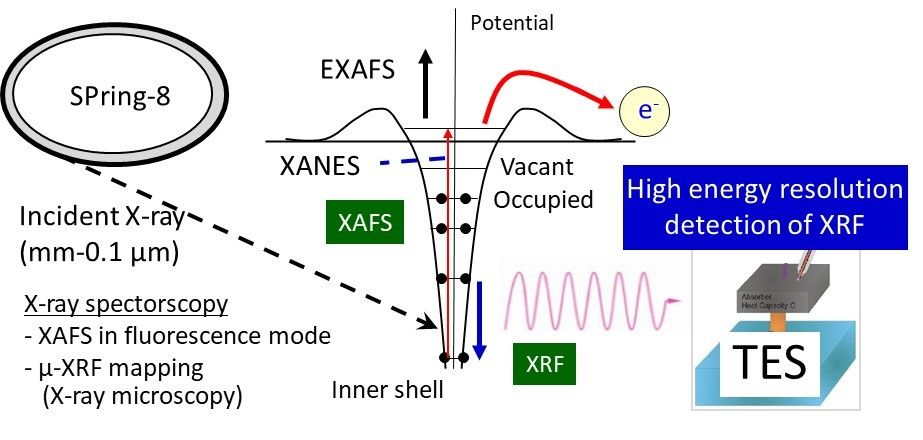| Program A01-4 | Advanced Earth and Planetary Sciences developed by application of TES to XAFS studies |
|---|---|
| Principal Investigator | TAKAHASHI, Yoshio (The University of Tokyo) |
High energy resolution fluorescence XAFS for the speciation of trace
elements in geochemical and environmental samples using
transition-edge sensor (TES) detector
Speciation of trace elements in environment is essential for better
understanding of their behaviors in environment. For this purpose,
X-ray absorption fine structure spectroscopy (XAFS) analysis in
fluorescence mode using intensity of X-ray fluorescence (XRF) to know
the degree of X-ray absorption is one of most useful methods, but
interference on the XRF signal of each trace element by those from
background elements is a severe problem to selectively obtain the
signal from trace elements. Transition-edge sensor (TES) detector is
one of most attractive energy-dispersive detectors to measure XRF
separately from other interference signals from coexistent elements
and scattering X-rays based on its high energy resolution detection
of X-rays (e.g., 5 eV at 6 keV), though the resolution is somewhat
lower than that of wavelength dispersive method using Bragg-type
crystal analyzer system with 1–2 eV energy resolution. We here study
potentials of TES for various X-ray spectroscopies including XAFS,
which consists of XANES (X-ray absorption near-edge structure) and
EXAFS (extended X-ray absorption fine structure), and X-ray emission
(XES) spectroscopy based on the high energy resolution. Three main
applications (Fig. 1) will be tested as follows:
(1) High-sensitive measurement of XAFS (mainly XANES) in the presence
of other interference elements for trace elements such as rare earth
elements (REE) and platinum (Pt) in weathered granite and marine
ferromanganese oxides, respectively, which are important as potential
metal resources of REE and Pt.
(2) Applications of TES for X-ray microscopy, in which elemental
mapping by the detection of XRF during scanning of sample in
micrometer or submicrometer scale. High separation ability of TES
enables us to obtain mapping of each element without any
interferences from other elements. Moreover, possible application of
shift of XES during the mapping will be conducted to know whether the
method can reflect variation of chemical species in the sample or
not.
(3) On the other hand, normal XANES is not very informative in terms
of chemical state analysis of various elements in the
samples. However, higher energy resolution detection of fluorescence
X-ray than the degree of lifetime broadening enables us to measure
XANES itself by better energy resolution, which is known as high
energy resolution fluorescence detection (HERFD) XANES. The
HERFD-XANES has more information on electronic state of each element
given by the method, by which we can extract chemical information to
the maximum degree possible. Thus, we here try to measure HERFD-XANES
for the speciation of cesium and barium adsorbed within the
interlayer of phyllosilicates.

Fig. 1. Development of XAFS and XRF spectroscopies using high
energy resolution power of TES.
Members
- Principal Investigator
-
TAKAHASHI, Yoshio

(Graduate School of Science, the University of Tokyo)
- Research Collaborators
-
YAMADA, Shinya (Rikkyo University)
OKADA, Shinji (Chubu University)
HASHIMOTO, Tadashi (Japan Atomic Energy Agency (JAEA))
Reference Materials
-
H. -B. Qin ,S. Yang ,M. Tanaka ,K. Sanematsu ,C. Arcilla ,Y. Takahashi , “Scandium immobilization by goethite: Surface adsorption versus structural incorporation,” Geochim. Cosmochim. Acta 294, 255–272 (2021). -
S. Yamada ,Y. Ichinohe ,H. Tatsuno ,R. Hayakawa ,H. Suda ,T. Ohashi ,Y. Ishisaki ,T. Uruga ,O. Sekizawa ,K. Nitta ,Y. Takahashi ,T. Itai ,H. Suga ,M. Nagasawa ,M. Tanaka ,M. Kurisu ,T. Hashimoto ,D. Bennett ,E. Denison ,W.B. Doriese ,M. Durkin ,J. Fowler ,G. O'Neil ,K. Morgan ,D. Schmidt ,D. Swetz ,J. Ullom ,L. Vale ,S. Okada ,T. Okumura ,T. Azuma ,T. Tamagawa ,T. Isobe ,S. Kohjiro ,H. Noda ,K. Tanaka ,A. Taguchi ,Y. Imai ,K. Sato ,T. Hayashi ,T. Kashiwabara ,K. Sakata , “Broadband high-energy resolution hard x-ray spectroscopy using transition edge sensors at SPring-8,” Rev. Sci. Instrum. 92(1), 013103 (2021). -
H. Miura ,Y. Kurihara ,M. Yamamoto ,A. Sakaguchi ,N. Yamaguchi ,O. Sekizawa ,K. Nitta ,S. Higaki ,D. Tsumune ,T. Itai ,Y. Takahashi , “Characterization of two types of cesium-bearing microparticles emitted from the Fukushima accident via multiple synchrotron radiation analyses,” Sci. Rep. 10(1), 11421 (2020). -
G. -I. Uramoto ,Y. Morono ,N. Tomioka ,S. Wakaki ,R. Nakada ,R. Wagai ,K. Uesugi ,A. Takeuchi ,M. Hoshino ,Y. Suzuki ,F. Shiraishi ,S. Mitsunobu ,H. Suga ,Y. Takeichi ,Y. Takahashi ,F. Inagaki , “Significant contribution of subseafloor microparticles to the global manganese budget,” Nat. Commun. 10(1), 400 (2019). -
Y. Takahashi ,Q. Fan ,H. Suga ,K. Tanaka ,A. Sakaguchi ,Y. Takeichi ,K. Ono ,K. Mase ,K. Kato ,V. V. Kanivets , “Comparison of solid-water partitions of radiocesium in river waters in Fukushima and Chernobyl Areas,” Sci. Rep. 7(1), 12407 (2017).
